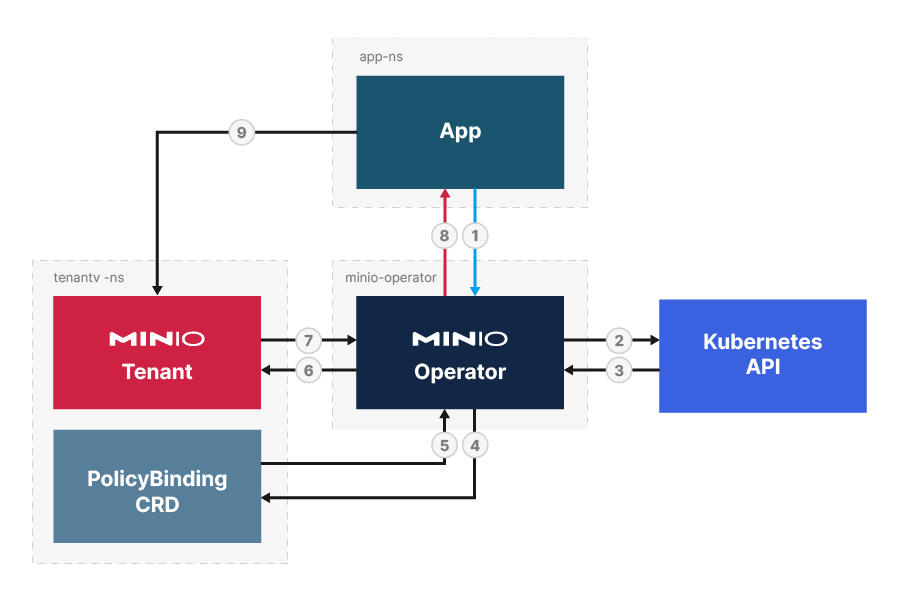Security Token Service (STS) for MinIO Operator
Overview
New in version Operator: v5.0.0
The MinIO Operator supports a set of API calls that allows an application to obtain STS credentials for a MinIO Tenant.
Benefits of STS for MinIO Operator include:
STS credentials allow an application to access objects on a MinIO Tenant without the need to create credentials for the application on the tenant.
Allows applications to access objects in MinIO tenants using a Kubernetes-native authentication mechanism.
Service Accounts or Service Account Tokens are a core concept of Role-Based Access Control (RBAC) authentication in Kubernetes.
Implementing STS for MinIO Operator allows you to utilize infrastructure as code principles and configuration by using the tenant custom resource definition (CRD) and a MinIO PolicyBinding CRD.
Important
Starting with Operator v5.0.11, STS is enabled by default.
Previous versions of the Operator start with STS disabled by default. To use STS with v5.0.10 or older versions of the Operator, you must first explicitly enable it.
The procedure on this page includes instructions to enable the STS API in the MinIO Operator.
Requirements
STS for the MinIO Operator requires the following:
MinIO Operator v5.0.0 or later.
The deployment must have TLS configured.
(Required for Operator v5.0.0 - 5.0.10)
OPERATOR_STS_ENABLEDenvironment variable set toon.
Procedure
Enable STS functionality for the deployment
Note
This step is optional for Operator version 5.0.11 or later.
kubectl -n minio-operator set env deployment/minio-operator OPERATOR_STS_ENABLED=on
Replace
minio-operatorwith the namespace for your deployment.Replace
deployment/minio-operatorwith the value for your deployment’s MinIO Operator.You can find the deployment value by running
kubectl get deployments -n <namespace>, where you replace<namespace>with the namespace for the MinIO Operator. Your MinIO Operator namespace is typicallyminio-operator, though this value can change during install.
Ensure an appropriate policy or policies exist on the MinIO Tenant for the application to use for the application
The next step uses a YAML document to map one or more existing tenant policies to a service account through a custom resource called a
PolicyBinding.Create YAML resources for the Service Account and Policy Binding:
Create the Service Account in the MinIO Tenant for the application to use.
For more on service accounts in Kubernetes, see the Kubernetes documentation.
Create a Policy Binding in the target tenant’s namespace that links the application to one or more of the MinIO Tenant’s policies.
Apply the YAML file to create the resources on the deployment
kubectl apply -k path/to/yaml/file.yaml
Use an SDK that supports the
AssumeRoleWithWebIdentitylike behavior to send a call from your application to the deploymentThe STS API expects a JWT for the service account to exist in the Kubernetes environment. When linked to a pod, such as through a deployment’s
.spec.spec.serviceAccountNamefield, Kubernetes mounts a JWT for the service account from a well-known location, such as/var/run/secrets/kubernetes.io/serviceaccount/token.Alternatively, you can define the token path as an environment variable:
AWS_WEB_IDENTITY_TOKEN_FILE=/var/run/secrets/kubernetes.io/serviceaccount/token
The following MinIO SDKs support
AssumeRoleRoleWithWebIdentity:For examples of using the SDKs to assume a role, see GitHub.
Example Resources
Service Account
A Service Account is a Kubernetes resource type that allows an external application to interact with the Kubernetes deployment.
When linked to a pod, such as through a deployment’s .spec.spec.serviceAccountName field, Kubernetes mounts a JWT for the service account from a well-known location, such as /var/run/secrets/kubernetes.io/serviceaccount/token.
The following yaml creates a service account called stsclient-sa for the sts-client namespace.
apiVersion: v1
kind: ServiceAccount
metadata:
namespace: sts-client # The namespace to add the service account to. Usually a tenant, but can be any namespace in the deployment.
name: stsclient-sa # The name to use for the service account.
Policy Binding
A PolicyBinding is a MinIO-specific custom resource type for Kubernetes that links an application to a set of policies.
Create Policy Bindings in the namespace of the tenant they are for.
For the purposes of the MinIO Operator, an application is any requesting resource that identifies with a specific service account and tenant namespace.
The PolicyBinding resource links the application to one or more policies for the tenant on that namespace.
The below yaml creates a PolicyBinding that links an application using the service account stsclient-sa that exists in the namespace sts-client to the policy test-bucket-rw in the target tenant located in the namespace minio-tenant-1.
The policies granted in the yaml definition must already exist on the MinIO Tenant.
apiVersion: sts.min.io/v1alpha1
kind: PolicyBinding
metadata:
name: binding-1
namespace: minio-tenant-1 # The namespace of the tenant this binding is for
spec:
application:
namespace: sts-client # The namespace that contains the service account for the application
serviceaccount: stsclient-sa # The service account to use for the application
policies:
- test-bucket-rw # A policy that already exists in the tenant
# - test-bucket-policy-2 # Add as many policies as needed
